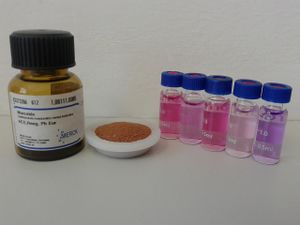Murexide
 Murexide sample and as solution. From left to right: dissolved in distilled water, in distilled water with NaOH, in tap water, in tap water with NaOH and in tap water with NaOH end point titrated with EDTA.
| |
| Names | |
|---|---|
| IUPAC name
Ammonium 2,6-dioxo-5-[(2,4,6-trioxo-5-hexahydropyrimidinylidene)amino]-3H-pyrimidin-4-olate
| |
| Other names
5,5'-Nitrilodibarbituric acid monoammonium salt
Ammonium purpurate C.I. 56085 MX Purpuric acid ammonium salt | |
| Properties | |
| C8H8N6O6 | |
| Molar mass | 284.19 g/mol |
| Appearance | Reddish-purple solid (dry) Purple-brownish solid (old) |
| Odor | Odorless |
| Melting point | Decomposes above 300 °C |
| Boiling point | Decomposes |
| Soluble | |
| Vapor pressure | ~0 mmHg |
| Hazards | |
| Safety data sheet | Sigma-Aldrich |
| Except where otherwise noted, data are given for materials in their standard state (at 25 °C [77 °F], 100 kPa). | |
| Infobox references | |
Murexide (NH4C8H4N5O6) or ammonium purpurate, is the ammonium salt of purpuric acid, used in analytical chemistry for determining the concentration of calcium in water samples, as well as rare earth metals.
Contents
[hide]Properties
Chemical
Murexide solutions change color in the presence of several metal ions, such as calcium or magnesium.
Murexide will slowly darken in air over long periods of time, due to oxidation.
Physical
Murexide is a reddish purple solid when dry, while older samples are more brownish in color. It is soluble in water,
Availability
Murexide can be purchased from chemical suppliers or online.
Preparation
There are several ways to synthesize murexide.
One route involves heating alloxantin in ammonia gas at 100 °C.
Another route involves refluxing uramil (5-aminobarbituric acid) with mercury oxide.
Projects
- Complexometric indicator
- Colorimetric reagent for calcium
Handling
Safety
Murexide is irritant, though no toxic or mutagen effects are known.
Storage
Murexide should be kept in closed bottles, away from light and corrosive vapors.
Disposal
No special disposal, can be poured down the drain.